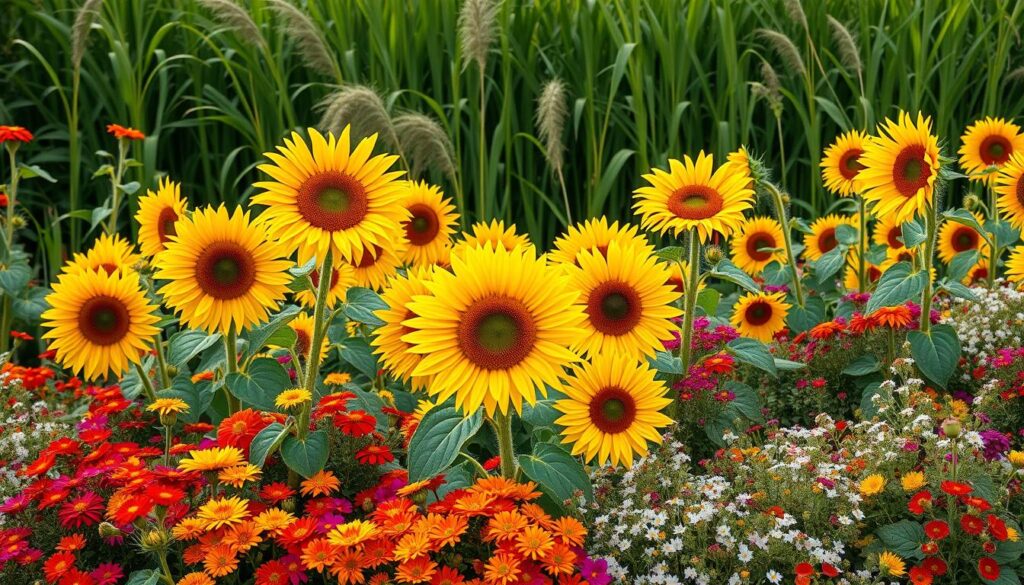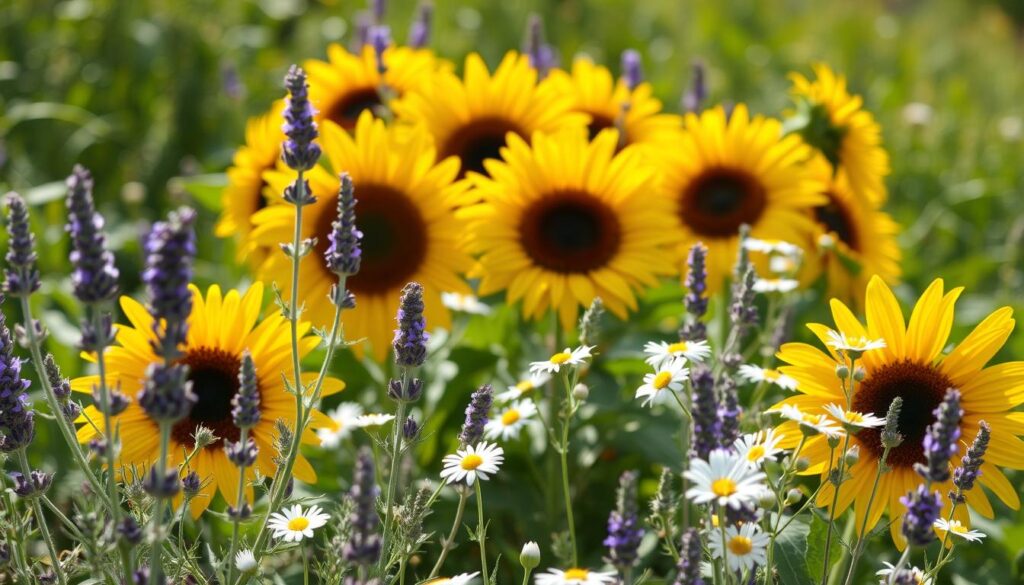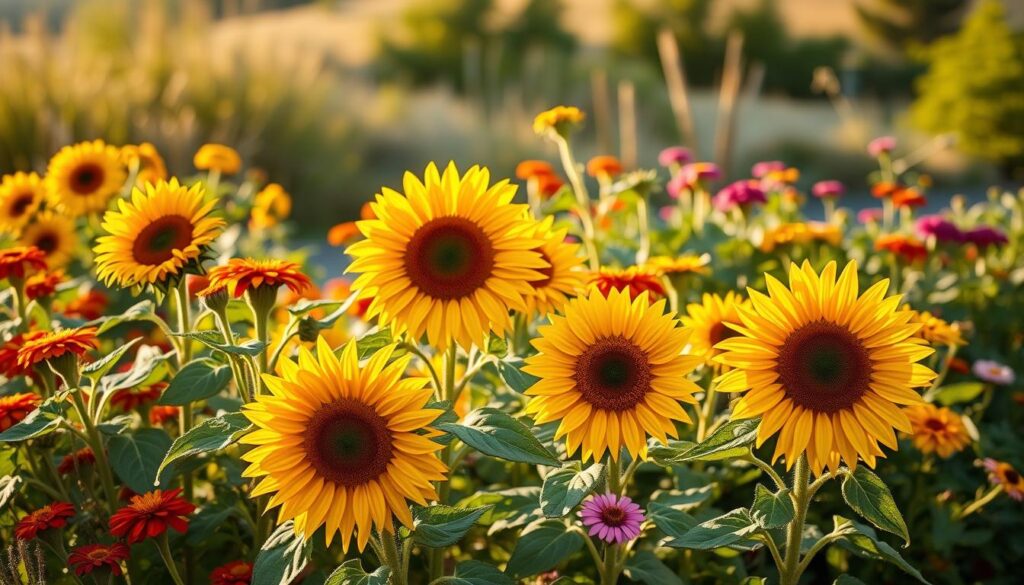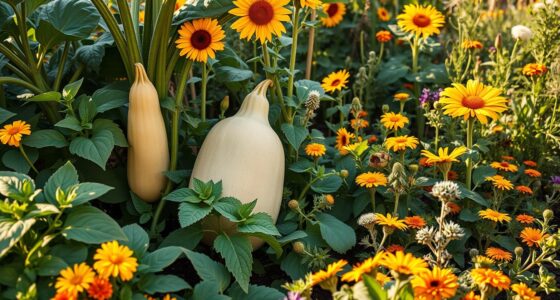Imagine standing in the middle of your garden, the sun casting a warm glow on vibrant yellow sunflower blooms swaying gently in the breeze. It’s a scene that captures joy and warmth, a reminder of the nurturing relationship between nature and life itself. As you delve into the world of sunflower companion plants, think of the thriving garden ecosystem you can create. It’s not just about growing flowers; it’s about fostering a sanctuary where every plant contributes to the health and beauty of its neighbors. By considering the best companion plants for sunflowers, you take a step toward enriching your garden and enhancing your harvest. In this guide, you’ll discover sunflower planting partners that not only thrive alongside these majestic blooms but also support them, making each garden moment more rewarding.
Key Takeaways
- Sunflowers thrive better with companion plants that promote pollinator activity.
- Certain vegetables, herbs, and flowers can enhance the growth of sunflowers.
- Sunflower companion plants help suppress weeds and reduce pests.
- Planning your garden layout with these partners improves overall health.
- Sunflowers can coexist harmoniously with a variety of garden favorites.
What Are Companion Plants?
Companion planting refers to the strategic practice of growing two or more plants together for their mutual benefit. By understanding which plants work well together, you maximize your garden’s potential. Plants can support each other in various ways, from providing shade and stability to deterring pests and enhancing growth.
Definition and Importance
In the realm of gardening, sunflower companion plants play a significant role in creating a thriving ecosystem. Companion planting promotes a balanced environment where different species can coexist while providing essential resources to one another. This method encourages biodiversity, which is vital for a sustainable garden.
Benefits for Your Garden
Exploring the benefits of companion planting showcases compelling reasons to adopt this approach. Here are some key advantages:
- Improved Growth: Companion plants share nutrients, enhancing the overall health of every species in your garden.
- Natural Pest Control: Certain plants can repel harmful insects, protecting their neighbors from damage.
- Enhanced Pollination: By attracting beneficial pollinators, plants can improve fruit and seed production.
By employing companion planting techniques, you optimize your sunflower garden’s health and beauty, ensuring that each plant contributes positively to the overall ecosystem.

Benefits of Planting Sunflowers
Planting sunflowers brings numerous advantages to your garden. These vibrant plants contribute not only to the ecological balance but also enhance the overall appeal of your outdoor space.
Attracting Pollinators
One of the most significant benefits of sunflowers lies in their ability to attract pollinators. The bright and bold sunflower attraction draws in bees and butterflies. As these pollinators visit sunflower blooms, they promote cross-pollination, benefiting other nearby plants as well. This creates a lively ecosystem thriving with activity.
Suppressing Weeds
Sunflowers act as effective ground cover, playing a crucial role in suppressing weeds. Their large leaves outcompete unwanted plants for essential resources such as sunlight and nutrients. This ability to create a dense canopy minimizes the growth of weeds, allowing for a more manageable garden space. Keeping weeds at bay reduces the time spent on manual weeding.
Enhancing Your Garden Aesthetics
The sunflower beauty contributes a cheerful ambiance to any garden. With their towering heights and striking yellow flowers, sunflowers introduce color and interest to your landscape. They not only serve practical purposes but also elevate the garden aesthetics, creating a welcoming environment for both you and your visitors.

Ideal Companion Plants for Sunflowers
When planning your garden, consider incorporating vegetable companions for sunflowers and herbal companions for sunflowers that thrive together. These combinations not only enhance growth but also create a vibrant and productive garden space.
Vegetables That Thrive with Sunflowers
Many vegetables grow remarkably well alongside sunflowers. Notable examples include:
- Tomatoes – They benefit from the shade of sunflower towers while gaining protection from pests.
- Zucchini – These plants can use the sunflower stalks for support, encouraging healthier growth.
- Cucumbers – Cup their climbing stems around sunflower stems for improved airflow and light exposure.
Herbs That Complement Sunflowers
Herbs also pair wonderfully with sunflowers. Some excellent herbal companions for sunflowers are:
- Basil – This aromatic herb deters pests with its strong scent, benefiting nearby plants.
- Chives – Their robust aroma acts as a natural insect repellent, supporting a thriving garden ecosystem.

Growing Sunflowers and Corn Together
Combining sunflowers and corn in your garden can prove to be a beneficial partnership. Both plants thrive in sunny locations and tend to have similar growth habits, creating a visually appealing and productive environment. This arrangement promotes healthy growth and encourages beneficial pollinators, enhancing overall yields.
Benefits of This Pairing
Planting sunflowers and corn together offers several advantages:
- Maximized space: They both grow tall yet do not compete for root space, allowing each to thrive.
- Attracting pollinators: Sunflowers draw in beneficial insects, helping with the pollination of corn.
- Improved resilience: The tall sunflowers can provide some shade to the corn, particularly during the hottest days.
Tips for Successful Growth
To make the most of your sunflowers and corn growing together, follow these essential tips:
- Space them adequately to allow for air circulation and sunlight access.
- Choose well-drained soil for optimal root development.
- Water sufficiently during the establishment phase to ensure strong growth.
- Stagger planting times to minimize nutrient competition between the two crops.

Sunflowers and Beans: A Perfect Match
Pairing sunflowers and beans in your garden can create a mutually beneficial relationship. Beans are well-known for their ability to perform nitrogen fixation, enriching the soil and providing essential nutrients that boost the growth of sunflowers. When you focus on planting sunflowers and beans together, you can maximize the advantages of both plants.
Nitrogen Fixation Benefits
Nitrogen fixation is a process where beans convert atmospheric nitrogen into a form that plants can use. This natural process benefits sunflowers significantly, as the added nitrogen enhances their growth and overall health. When the soil is rich in nitrogen, sunflowers can produce more vibrant blooms and stronger stalks, making for a visually stunning garden.
How to Plant Together
For successful planting, select bean varieties that grow low to the ground. This choice ensures that they do not compete with sunflowers for sunlight. Timing is key; plant your beans once sunflowers have reached a respectable height to ensure both can thrive. Adequate spacing is essential, allowing ample room for growth. Consider your garden layout to create a harmonious and beneficial environment for both sunflowers and beans.

Attracting Beneficial Insects with Sunflowers
Sunflowers are a valuable addition to any garden, particularly because they attract a variety of beneficial insects. These insects play crucial roles, such as pollinating your plants and assisting in natural pest control. By incorporating sunflowers into your landscape, you can create a vibrant ecosystem that promotes health and vitality in your garden.
Pollinators You’ll Love
One of the most appealing aspects of growing sunflowers is their ability to attract pollinators with sunflowers. Bees, butterflies, and other pollinating species are drawn to the bright, nectar-rich blooms. This interaction not only enhances the beauty of your garden but also significantly increases the yield of fruits and vegetables, thanks to effective pollination.
Natural Pest Control Insects
In addition to attracting pollinators, sunflowers also invite insects that help sunflowers by naturally controlling pest populations. Predatory insects like ladybugs and lacewings love to feast on harmful pests such as aphids and spider mites. By fostering an encouraging environment for these beneficial insects, you can reduce the need for chemical insecticides, resulting in a healthier garden ecosystem.

| Beneficial Insects | Role in the Garden | Pests Targeted |
|---|---|---|
| Bees | Pollination | N/A |
| Ladybugs | Natural pest control | Aphids, spider mites |
| Lacewings | Natural pest control | Aphids, mealybugs |
| Butterflies | Pollination | N/A |
By integrating sunflowers into your garden plan, you create a welcoming habitat for these beneficial insects. This enhances biodiversity and supports a thriving garden, showcasing the synergy between plants and their insect allies.
Sunflower and Tomato Companions
Planting sunflowers and tomatoes together can yield numerous benefits. These plants complement each other quite well, creating a thriving garden ecosystem. When you explore companion planting tomatoes with sunflowers, you’ll see how they enhance growth while providing a natural pest deterrent. The sunflowers not only attract beneficial insects but also provide shade that helps in maintaining the moisture levels your tomatoes need.
Why They Work Well Together
Sunflowers create an ideal environment for tomatoes by shielding them from harsh sunlight and providing support as they grow. In addition, sunflowers can deter common pests that typically target tomatoes, leading to healthier plants and potentially higher yields. When you implement companion planting tomatoes with sunflowers, you foster a gardening dynamic that benefits both types of plants.
Tips for Planting in Proximity
For optimal results, consider these planting tips for sunflowers and tomatoes:
- Select dwarf sunflower varieties to minimize competition for space.
- Space tomatoes appropriately to ensure they get enough sunlight and air circulation.
- Water both plants adequately, keeping in mind their moisture needs.
- Monitor for pests and diseases regularly to maintain a healthy garden.

Using Flowers as Companion Plants
In the world of gardening, flowers can often play more than just a decorative role. Certain floral companions like marigolds and borage can enhance not only the beauty of your garden but also its overall health and productivity. Understanding how to utilize these flowers effectively will elevate your gardening experience.
Marigolds: More Than Just Pretty Faces
Marigolds serve as effective companions in your garden, with significant benefits of marigolds being their ability to repel pests. These vibrant flowers can deter harmful nematodes and aphids, protecting nearby plants like sunflowers from damage. Planting marigolds as companions with sunflowers not only beautifies your space but also supports pest management. Their bold colors and delightful fragrance create an eye-catching display, making them a must-have in any companion planting strategy.
Borage: A Must-Have Flower Partner
Borage with sunflowers thrives in sunny garden spots, enriching the area with its unique characteristics. This flower is famous for attracting pollinators, which benefits not only itself but also neighboring plants. Furthermore, borage can improve soil health, making it a wonderful choice for flower companions. Its lush growth supports other plants, ensuring a thriving environment for your sunflowers and more. Adding borage to your garden promotes a vibrant ecosystem that supports vegetative growth and biodiversity.

| Flower | Benefits | Companion Plants |
|---|---|---|
| Marigolds | Repels pests, vibrant colors | Sunflowers, tomatoes, peppers |
| Borage | Attracts pollinators, improves soil health | Sunflowers, strawberries, cabbages |
By choosing the right flowers as companions, your garden can flourish in both health and aesthetics. Marigolds and borage not only provide visual appeal but also promote a thriving ecosystem, making your gardening efforts even more rewarding.
Avoiding Bad Companions for Sunflowers
Planting sunflowers can enhance your garden, but understanding the bad companions for sunflowers is crucial for their success. Certain plants can negatively affect sunflower growth, leading to undesirable results. Ignoring these companion planting rules can lead to signs of poor plant compatibility, which may manifest in various ways.
Plants to Keep Away
Avoid growing sunflowers near potatoes or pole beans. These plants may suffer from allelopathic effects, impacting their health and yield. Shade-loving plants, such as hostas, should also be kept at a distance due to their differing light requirements. Mixing these types can lead to stunted growth and hinder the performance of your sunflowers.
Signs of Poor Plant Relations
Recognizing signs of poor plant compatibility can save you from losing valuable garden space. Stunted growth or lack of flowers are key indicators that something is amiss. Additionally, if you notice unexpected insect infestations around your sunflowers, it may signal that the companion plants nearby are not beneficial. Pay attention to these signs to maintain a thriving garden.

Tips on Planting Companion Gardens
Creating a successful companion garden arrangement requires thoughtful planning and consideration. You want to ensure that taller plants are positioned at the back, allowing shorter varieties to receive sufficient sunlight. Grouping plants with similar nutrient needs promotes healthy growth while simplifying your watering schedule. These strategies can significantly enhance the overall productivity of your garden.
Arrangement for Optimal Growth
When planning your garden layout, remember to prioritize plant heights and growth patterns. Sunflowers, for example, should take center stage as they rise above companion plants. This arrangement maximizes sunlight access for all plants involved. Additionally, consider the mature sizes of your chosen plants; overcrowding can lead to competition for resources.
Seasonal Considerations
Timing plays a pivotal role in achieving garden harmony. Using seasonal planting tips can help you select compatible varieties to grow at the same time. Pairing plants that flourish together ensures mutual support throughout their growing phases. By coordinating your planting schedule, you can enjoy a prolonged harvest and a vibrant display in your garden.

Maintaining Your Sunflower Companions
Caring for sunflower companions requires attention to both watering and fertilization practices. Ensuring your plants receive the right care encourages healthy growth and a flourishing garden. Here are some tips that will help you maintain your sunflower companions effectively.
Watering and Care Tips
Regular watering is crucial for sunflowers and their companion plants. Initially, ensure they receive ample moisture to establish roots. Once they are settled, reduce the frequency of watering to promote deeper root growth. Deeper roots enhance stability and allow your plants to access nutrients more effectively.
Fertilization Guidelines
Sunflowers thrive in nutrient-rich soil. Incorporating compost helps provide essential nutrients without the risks associated with excessive fertilizers. Monitor the health of your soil regularly, and adjust your care routines based on your observations. Proper fertilizing companion plants will support their growth while maintaining an optimal environment for sunflowers.

| Care Aspect | Recommendation |
|---|---|
| Watering Frequency | Initially high; reduce once established |
| Soil Type | Nutrient-rich, well-draining soil |
| Fertilizer Type | Compost preferred; limit chemical fertilizers |
| Monitoring | Check soil health regularly |
Harvesting and Enjoying Your Companion Garden
Harvesting sunflowers marks a rewarding time in your gardening journey. To ensure you enjoy the best flavors, it’s crucial to know when to pick them. Once the seeds are fully formed, and the back of the heads have turned yellow, you can begin your harvest. This timing not only maximizes the nutrient density of the seeds but also makes a delightful treat for you and local wildlife.
When to Harvest Sunflowers
The ideal time for harvesting sunflowers is when the seeds appear plump and the large flower heads start to droop. Monitor your sunflowers closely, as harvesting a bit late can attract unwelcome pests. You might also notice that the seeds have become dark, which is another great indicator that it’s time to reap your rewards. Cut the heads off carefully and follow up with proper drying techniques to preserve their flavor.
Recipes for Sunflower Seeds
After harvesting sunflowers, you can look forward to delicious recipes using sunflower seeds. Roasting the seeds brings out a rich, nutty flavor that makes them perfect for snacks or culinary creations. Season them to your liking with garlic, chili, or rosemary for a tasty twist. Add them to salads, granola mixes, or baked goods for an extra crunch. The versatility of sunflower seeds allows you to experiment and find your favorite flavor combinations.

| Recipe | Main Ingredients | Cooking Time |
|---|---|---|
| Roasted Sunflower Seeds | Sunflower seeds, olive oil, salt | 20 minutes |
| Sunflower Seed Granola | Oats, sunflower seeds, honey, nuts | 30 minutes |
| Sunflower Seed Salad Topping | Mixed greens, sunflower seeds, vinaigrette | 10 minutes |
| Sunflower Seed Energy Bites | Sunflower seeds, dates, chocolate chips | 15 minutes |
Conclusion: Create Your Companion Planting Strategy
Reflecting on your garden layout for companion planting is essential for maximizing your gardening success. By carefully planning where each plant goes, you can ensure that your sunflowers and their companions receive optimal sunlight and space to grow. This thoughtful arrangement not only enhances plant health but also helps to mitigate common gardening challenges.
Moreover, embracing the diversity in garden planting creates a vibrant ecosystem. A variety of companion plants fosters beneficial relationships among your flora, leading to improved growth and resilience. The mix of colors, textures, and scents adds visual appeal, turning your garden into an inviting space while promoting sustainable gardening practices.
Incorporating these elements into your gardening strategy will ultimately lead to a more productive and harmonious garden. By reflecting on your layout and promoting diversity, you set the stage for a flourishing environment that benefits both you and your plants.









